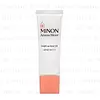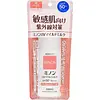What's inside
What's inside
 Key Ingredients
Key Ingredients

 Benefits
Benefits

 Concerns
Concerns

 Ingredients Side-by-side
Ingredients Side-by-side

Water
Skin ConditioningCyclopentasiloxane
EmollientTitanium Dioxide
Cosmetic ColorantDiphenylsiloxy Phenyl Trimethicone
Skin ConditioningPEG-9 Polydimethylsiloxyethyl Dimethicone
EmulsifyingOctyldodecyl Myristate
EmollientTriethylhexanoin
MaskingPentylene Glycol
Skin ConditioningButylene Glycol
HumectantCetyl PEG/PPG-10/1 Dimethicone
EmulsifyingDisteardimonium Hectorite
StabilisingTrimethylsiloxysilicate
EmollientLauroyl Lysine
Skin ConditioningVinyl Dimethicone/Methicone Silsesquioxane Crosspolymer
Zinc Chloride
AntimicrobialPotassium Hydroxide
BufferingStearic Acid
CleansingDipentaerythrityl Tri-Polyhydroxystearate
EmollientPhytosteryl/Octyldodecyl Lauroyl Glutamate
Skin ConditioningTribehenin
EmollientPhenoxyethanol
PreservativeVinyl Dimethicone/Lauryl Dimethicone Crosspolymer
Tocopherol
AntioxidantStearyl Glycyrrhetinate
Skin ConditioningMethicone
EmollientBifida Polysaccharide
HumectantPPG-12
Skin ConditioningSilica
AbrasiveLimnanthes Alba Seed Oil
Skin ConditioningCarnosine
Skin ConditioningTaurine
BufferingGlycerin
HumectantLysine Hcl
Skin ConditioningPolyquaternium-61
Skin ConditioningGlutamic Acid
HumectantGlycine
BufferingLeucine
Skin ConditioningHistidine Hcl
Skin ConditioningSerine
MaskingValine
MaskingTin Oxide
AbrasiveZinc Aspartate
Skin ConditioningThreonine
Alanine
MaskingIsoleucine
Skin ConditioningAllantoin
Skin ConditioningPhenylalanine
MaskingArginine
MaskingProline
Skin ConditioningTyrosine
MaskingAlginic Acid
Skin ConditioningDisodium Guanylate
EmollientTalc
AbrasiveDimethicone
EmollientBoron Nitride
AbsorbentCI 77492
Cosmetic ColorantWater, Cyclopentasiloxane, Titanium Dioxide, Diphenylsiloxy Phenyl Trimethicone, PEG-9 Polydimethylsiloxyethyl Dimethicone, Octyldodecyl Myristate, Triethylhexanoin, Pentylene Glycol, Butylene Glycol, Cetyl PEG/PPG-10/1 Dimethicone, Disteardimonium Hectorite, Trimethylsiloxysilicate, Lauroyl Lysine, Vinyl Dimethicone/Methicone Silsesquioxane Crosspolymer, Zinc Chloride, Potassium Hydroxide, Stearic Acid, Dipentaerythrityl Tri-Polyhydroxystearate, Phytosteryl/Octyldodecyl Lauroyl Glutamate, Tribehenin, Phenoxyethanol, Vinyl Dimethicone/Lauryl Dimethicone Crosspolymer, Tocopherol, Stearyl Glycyrrhetinate, Methicone, Bifida Polysaccharide, PPG-12, Silica, Limnanthes Alba Seed Oil, Carnosine, Taurine, Glycerin, Lysine Hcl, Polyquaternium-61, Glutamic Acid, Glycine, Leucine, Histidine Hcl, Serine, Valine, Tin Oxide, Zinc Aspartate, Threonine, Alanine, Isoleucine, Allantoin, Phenylalanine, Arginine, Proline, Tyrosine, Alginic Acid, Disodium Guanylate, Talc, Dimethicone, Boron Nitride, CI 77492
Cyclopentasiloxane
EmollientEthylhexyl PCA
HumectantDimethicone
EmollientDiisostearyl Malate
EmollientSoy Acid
EmollientZiyu Glycoside I
Skin ConditioningPolyhydroxystearic Acid
EmulsifyingAlumina
AbrasivePEG-8 Dimethicone
EmulsifyingMagnesium Hydride
AntioxidantStearic Acid
CleansingAluminum Hydroxide
EmollientCholesteryl/Behenyl/Octyldodecyl Lauroyl Glutamate
Skin ConditioningPhenoxyethanol
PreservativeSilica
AbrasiveGlycogen
HumectantCholesterol
EmollientCyclopentasiloxane, Ethylhexyl PCA, Dimethicone, Diisostearyl Malate, Soy Acid, Ziyu Glycoside I, Polyhydroxystearic Acid, Alumina, PEG-8 Dimethicone, Magnesium Hydride, Stearic Acid, Aluminum Hydroxide, Cholesteryl/Behenyl/Octyldodecyl Lauroyl Glutamate, Phenoxyethanol, Silica, Glycogen, Cholesterol
Alternatives
Ingredients Explained
These ingredients are found in both products.
Ingredients higher up in an ingredient list are typically present in a larger amount.
Cyclopentasiloxane, or D5, is a silicone used to improve texture of products and trap moisture.
D5 is considered lightweight and volatile. Volatile means it evaporates quickly after application. Once evaporated, D5 leaves a thin barrier that helps keep skin hydrated.
It is also an emollient. Emollients help soften the skin and prevent water loss. Silicones create a silky texture in products. D5 helps other ingredients become more spreadable.
Studies show D5 is safe to use in skincare products. We recommend speaking with a skincare professional if you have concerns.
Learn more about CyclopentasiloxaneDimethicone is a type of synthetic silicone created from natural materials such as quartz.
What it does:
Dimethicone comes in different viscosities:
Depending on the viscosity, dimethicone has different properties.
Ingredients lists don't always show which type is used, so we recommend reaching out to the brand if you have questions about the viscosity.
This ingredient is unlikely to cause irritation because it does not get absorbed into skin. However, people with silicone allergies should be careful about using this ingredient.
Note: Dimethicone may contribute to pilling. This is because it is not oil or water soluble, so pilling may occur when layered with products. When mixed with heavy oils in a formula, the outcome is also quite greasy.
Learn more about DimethiconePhenoxyethanol is a preservative that has germicide, antimicrobial, and aromatic properties. Studies show that phenoxyethanol can prevent microbial growth. By itself, it has a scent that is similar to that of a rose.
It's often used in formulations along with Caprylyl Glycol to preserve the shelf life of products.
Silica, also known as silicon dioxide, is a naturally occurring mineral. It is used as a fine, spherical, and porous powder in cosmetics.
Though it has exfoliant properties, the function of silica varies depending on the product.
The unique structure of silica enhances the spreadability and adds smoothness, making it a great texture enhancer.
It is also used as an active carrier, emulsifier, and mattifier due to its ability to absorb excess oil.
In some products, tiny microneedles called spicules are made from silica or hydrolyzed sponge. When you rub them in, they lightly polish away dead skin layers and enhance the penetration of active ingredients.
Learn more about SilicaStearic Acid is a fatty acid. It is an emollient, emulsifier, and texture enhancer.
As an emollient, stearic acid helps soften skin. It aids the skin's protective barrier by preventing water loss. It also provides a gentle cleansing effect without stripping away natural oils.
Stearic acid may also be used to enhance the texture of products. It can add volume and stabilize ingredients such as water and oil. This can help water and oil ingredients from separating.
Sources of stearic acid include animal or vegetable fats/oils such as coconut or shea. It can be naturally found in butter, cocoa butter, shea butter, vegetable fats, and animal tallow.
This ingredient may not be Malassezia folliculitis, or fungal-acne safe.
Learn more about Stearic Acid